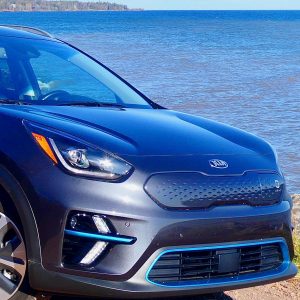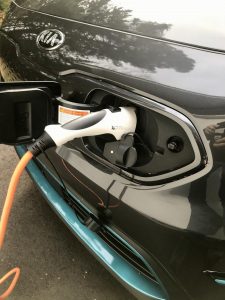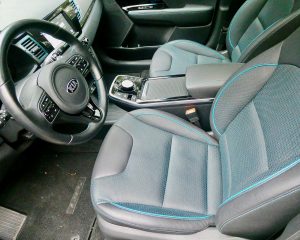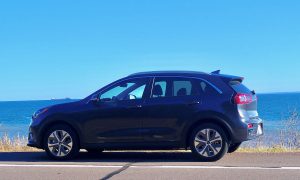Niro requires no fiddling to electrify driving
By John Gilbert
If you have an odd sense of humor, you can use it to fool and confuse your friends when you’re driving a Kia Niro EV. Park it in a parking lot and ask if anyone can help locate the gas filler. They can walk around the car, several times, but they won’t find one. There isn’t one.
Then ask if any of them hear anything unusual as you drive away. Hit the gas pedal and Zap! You have accelerated away. When you come back, they will tell you they didn’t hear anything odd, because they didn’t hear anything at all. There is no sound, because there is no gasoline engine. The Niro EV is pure-electric, going beyond the hybrid Niro and plug-in hybrid Niro.
The Niro is Kia’s newly introduced compact SUV, sort of. It looks like a crossover SUV, it has the room of a compact crossover SUV, which it resembles far more than any rank-and-file car. The major hint is the terminology “EV.” That stands for Electric Vehicle. So there is no place for a gas filler, because there is no gasoline engine under the hood.
It’s not a Tesla, or any of those exotic, $100,000-plus luxury vehicles. It is an under-$50,000 wagon that looks like a compact SUV, which aims to show us where our cars of the future are heading. It’s “fuel economy” figure on the sticker shows 123 miles per gallon city, 102 highway, or 112 MPGe combined. The lower-case “e” after MPG stands for “electric.” It is a symbol of a changing world, which is fast approaching.
The Niro is silent-running, and when you switch it on, don’t wait for an engine sound, just look for the little sign on the instrument panel that says “ready to drive.” Switch the rotary knob on the console to “D” and you’re off. There is also an “R” indicator to the right, and an “N” for neutral, and the little round circle with a “P” on it in the middle of the shift knob is for park. When you stop, or park, make sure you hit the P, and you might want to make sure it is shown on the instrument panel, or the silent-running Niro might go home without you!
The Niro is very comfortable for four or five, and it is both quick and good-handling both in city driving or cruising on a freeway, where you are amazed at how quick it is, and pleasantly surprised at how easy it is to hear conversations, or the fine audio system, because there is no engine noise.
The Niro seems to be facing its own identity crisis, possibly trying to decide if it is a luxury car, a sporty car, or an SUV. Think I’m exaggerating? Motor Trend runs an annual issue with capsules showing all the new cars, and a different issue showing all the new SUVs. I checked it out for the Niro among the small SUVs, but it wasn’t there. Then I pulled out the car issue, and, sure enough, Motor Trend showed the Niro among the cars. There are other compact crossovers without all-wheel-drive that don’t get insulted by being placed with cars, but the Niro seems OK with it.
My appreciation of hybrid vehicles has been increasing at about the same rate that coordinated gas-electric hybrids have been moving into increasingly prominent roles in the auto industry. Knowing that the gas engine will recharge the electric motor is comforting, but I have had trouble getting my hands on anything from one elusive segment, up on the great North Shore of Lake Superior, and that is an EV — a pure electric vehicle.
Brief drives in vehicles such as the Nissan Leaf, left a strong impression, although its earliest models had a modest range of 20-something miles. There were others, too, but the manufacturers who build pure electric vehicles, with real-world driving range capabilities, pretty much ignore what we endearingly call “flyover land.” The reason is obvious on a couple of counts.
One, the expense of installing rapid charging stations naturally placed them in high-population areas like Los Angeles, or San Francisco, or the New York-Boston area of the East Coast. Maybe Florida. Second, it gets cold in the Great White North, really cold, and that can knock the starch out of the driving range of battery packs.
But EV-makers shouldn’t overlook the Upper Midwest. I keep writing that we’re all headed toward a world of electric-powered cars, and we’ve done well with hybrids and plug-in hybrids. Not only that, but we have a few EV charging stations in Minnesota — mostly in the Twin Cities of Minneapolis-St. Paul, but a few in Duluth, right up here on the often-freezing tip of Lake Superior.
When I was notified that a vehicle would be delivered from a press fleet operation in Chicago, and it would be the Kia Niro EV, they informed me that it would be delivered to my house up the hill from the North Shore in rural Duluth, in an enclosed trailer.
Sure enough, the vehicle was a 2019 Kia Niro EV, in EX Premium trim. That’s a lot of suffixes, but the EX and Premium tags just denote various creature comfort packages on the particular vehicle coming my way. The car is Kia’s version of a similar drivetrain in the Hyundai Ionic, and more recently the Hyundai Kona compact SUV.
The Niro resembles a compact SUV, but it really is an example of how the South Korean partners are now differentiating their models. The Ionic is a slick compact sedan with large-car interior space, while the Kia designers took the same platform and built it up into an SUV-style vehicle using the same powertrain.
That powertrain is a 64 kilowatt-hour Lithium-Ion Polymer battery pack, built low and streamlined by LG Chem, a South Korean electronics innovator, and it produces 150 kilowatt-hours — or 201 horsepower — through an AC synchronous motor. It also has a 7.2 kilowatt on-board charger, and a DC fast-charge port for 480 volts in the front grille. It is concealed behind a small horizontal trap door on the end of what looks like a trim bar. Pop it open, pull the charge cable out from its receptacle under the hatch, and you can plug it into a normal household outlet, or a high-voltage outlet, or a special quick-charge outlet if you can locate one.
I plugged the Niro into an outdoor plug-in and recharged it over night. But the most astounding thing about the whole week came when I clicked onto Google with my iPhone and asked for “EV car-charging stations in Duluth, Minnesota,” and it came back with several. The one that most interested me was at the University of Minnesota-Duluth, in the lot near the administration building, where two charging stations were located at the end of a long row of parking meters. Charge-Point, the company that makes the charging units, worked out an arrangement with UMD to install the two chargers, one normal and one fast-charge, and for its part of the bargain, UMD offers free usage of the charging stations for up to 4 hours at a time. That’s for students, faculty, visitors, and any residents who might come and plug in.
A small horizontal spring-loaded trap door in the grille reveals the covered connector, and you simply plug in the cable in the trunk floor, or the connector from a charge station, and as simply as you might use a credit card to plug a coin meter you’re set for as long as you want to charge. The connector locks in, and can’t be removed without the coded card from ChargePoint, to prevent the bad guys from stealing your car.
When the Niro was delivered, it showed a workable range of 268 miles. That’s a lot. If yuo drive it precisely, you could get more, or less, if you want to hot-rod around. I charged mine at home, overnight, on a normal outlet. It showed I had reached 54 percent of capacity. I was disappointed I didn’t get more, but then I read that the most efficient way to insure long life for your battery pack is to charge it up to about halfway, then drive it.
The price of the Niro is $44,000, and if you add the numerous features of the test vehicle, such as the sunroof, Harmon Kardon audio upgrade, navigation and perforated leather seats, it rises to $47,155.
Friends mostly said, “I don’t want an electric car.” So I asked how much they pay a week for gasoline, and the norm was about $20 a week, to to work and back. I pointed out that 268 miles of range would get me through a whole week easily, and on the weekend, I could go to a UMD football or volleyball game, plug in the car at the free charge station, and recharge it enough to make it through the next week. If you did that, you would switch from paying $20 per week for gasoline, to paying $0 per week, for the year. That’s right — absolutely nothing for fuel for your car if you use the free-charge device. If you don’t, you can always go to one of the available credit card pay-recharge stations.
It’s common to drive from Duluth to Minneapolis and back in a day for business, or for a weekend, and it’s about 140 miles away. So you make it one way with ease, and if you don’t recharge in Minneapolis, you could head back home and stop for a little dinner along the way, getting enough of a charge while you’re eating to make it the rest of the way.
The Niro handles remarkably well, because the mostly flat, horizontal battery pack runs longitudinally, up the middle under the rear seat, sort of like a spine. It also locates a large portion of the car’s weight between the axles, giving the Niro the same benefit a mid-engine sports car gets from such placement.
Along with the expected safety features and electronic convenience and security items, the test Niro EV has a cold weather package that includes a battery heater and a heat pump that forces heated liquid to the battery pack to greatly reduce the normal power loss severe cold can do to battery packs. Warming up the battery pack makes it easier to operate in cold, as well.
Kia’s owner’s manual states that using normal AC charging ensures optimal battery life and is preferable to DC charging. Also, charging for the amount of range you need is better than fully charging, it says here, and you can set the Niro to shut off charging when the optimum charge is reached. Among other of its numerous safety fittings, such as lane-change, lane-departure, lane-following, collision-avoidance, etc., there are also fun features such as a mode switch that lets you instantly click to sport for improved acceleration.
Kia also resisted the urge to install a continuously variable transmission, and instead uses the superb in-house 7-speed dual-clutch automatic that adds to the sporty feel. Shift paddles on the steering wheel enhance that feel even more.
My favorite Kia contact says the Niro has been selling on the West Coast for almost six months, and they are selling so fast that Kia has held off introducing its Soul-E, its next electric vehicle. I think the fact that the charging stations are already showing up in such outposts as Duluth, the logical move to sell more pure-electric cars in the Upper Midwest has got to be coming. We’re all going to be driving electric, sooner or later, so we might as well get on with it.









 John Gilbert is a lifetime Minnesotan and career journalist, specializing in cars and sports during and since spending 30 years at the Minneapolis Tribune, now the Star Tribune. More recently, he has continued translating the high-tech world of autos and sharing his passionate insights as a freelance writer/photographer/broadcaster. A member of the prestigious North American Car and Truck of the Year jury since 1993. John can be heard Monday-Friday from 9-11am on 610 KDAL(www.kdal610.com) on the "John Gilbert Show," and writes a column in the Duluth Reader.
John Gilbert is a lifetime Minnesotan and career journalist, specializing in cars and sports during and since spending 30 years at the Minneapolis Tribune, now the Star Tribune. More recently, he has continued translating the high-tech world of autos and sharing his passionate insights as a freelance writer/photographer/broadcaster. A member of the prestigious North American Car and Truck of the Year jury since 1993. John can be heard Monday-Friday from 9-11am on 610 KDAL(www.kdal610.com) on the "John Gilbert Show," and writes a column in the Duluth Reader.